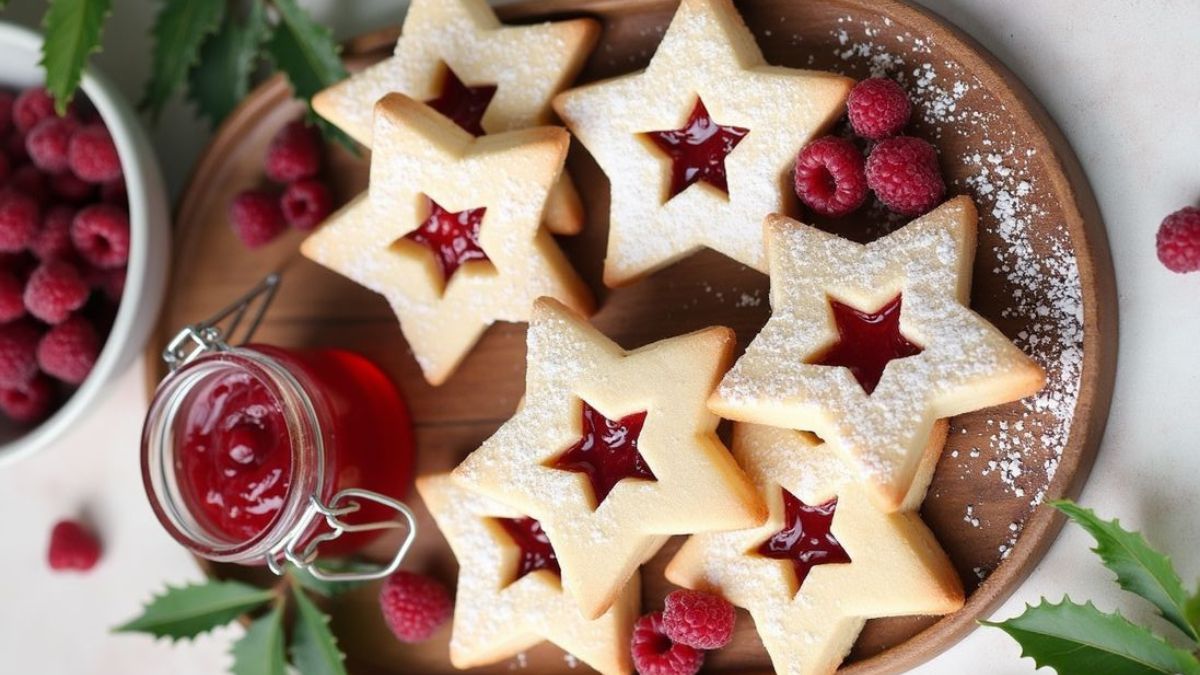In the heart of Eastern Europe, nestled between rolling hills, dense forests, and the Baltic Sea, lies Lithuania—a country rich in culture, folklore, and culinary traditions. Among its many gastronomic treasures, one humble yet beloved treat stands out for its simplicity, elegance, and nostalgic warmth: biskociai. These delicate butter cookies, often enjoyed with tea or coffee, have graced Lithuanian tables for generations. Though unassuming in appearance, biskociai carry with them centuries of tradition, family memories, and a deep connection to seasonal celebrations. This article explores the origins, cultural significance, ingredients, preparation methods, regional variations, and modern interpretations of biskociai, offering a comprehensive look at why these cookies continue to hold a special place in Lithuanian hearts—and increasingly, in the kitchens of curious bakers worldwide.
What Are Biskociai?
At their core, biskociai are crisp, buttery cookies made primarily from flour, butter, sugar, and egg yolks. The name itself derives from the French word “biscuit,” reflecting the historical influence of Western European baking traditions on Lithuanian cuisine—particularly during the 18th and 19th centuries, when French culinary styles were fashionable among the nobility. Over time, this borrowed concept evolved into a distinctly Lithuanian confection, adapted to local tastes and pantry staples.
Unlike soft, chewy cookies common in American baking, biskociai are intentionally crisp and light, often described as “melt-in-your-mouth.” Their texture is achieved through a high butter-to-flour ratio and careful handling of the dough to avoid overworking the gluten. Traditionally, they are shaped by hand into small rounds or crescents, sometimes pressed with decorative molds or stamped with family heirloom cookie cutters. A light dusting of powdered sugar before or after baking adds a subtle sweetness and visual elegance.
While they may resemble shortbread or spritz cookies to the untrained eye, biskociai possess a uniquely Lithuanian character—less sweet, more butter-forward, and imbued with a quiet sophistication that reflects the country’s understated culinary aesthetic.
Historical Roots and Cultural Significance
The story of biskociai is intertwined with Lithuania’s complex history. During the Polish-Lithuanian Commonwealth (1569–1795), the Lithuanian nobility adopted many customs from Western Europe, including refined baking techniques. French and German influences seeped into manor kitchens, where skilled cooks began experimenting with butter-rich pastries and cookies. Biskociai likely emerged from this cultural exchange, blending imported techniques with local ingredients like farm-fresh butter and eggs.
However, it was in rural households that biskociai truly became a staple. While noble estates had access to sugar and refined flour, peasant families adapted the recipe using what they had—often substituting honey for sugar or using coarser flours. Despite these variations, the essence of biskociai remained: a celebration of butter, a symbol of hospitality, and a treat reserved for special occasions.
In Lithuanian culture, food is rarely just sustenance—it’s a vessel for memory and meaning. Biskociai are especially associated with holidays like Christmas (Kalėdos) and Easter (Velykos), when families gather to bake and share traditional foods. Grandmothers would prepare large batches, storing them in tins to offer guests throughout the festive season. The act of making biskociai became a ritual, passed down through generations, with each family guarding its own subtle tweaks to the recipe—perhaps a splash of vanilla, a hint of lemon zest, or a specific shaping technique.
Even today, offering biskociai to visitors is considered a gesture of warmth and welcome. Their delicate nature mirrors the Lithuanian value of “švelnumas” (gentleness)—a cultural ideal that prizes quiet kindness, modesty, and care.
Key Ingredients and Their Roles
The magic of biskociai lies in their simplicity. With only a handful of ingredients, each component plays a vital role in achieving the cookie’s signature texture and flavor:
- Butter: The star of the show. High-quality, unsalted butter (preferably European-style with a higher fat content) provides richness, tenderness, and that unmistakable melt-in-the-mouth quality. It should be softened but not melted—room temperature is ideal for creaming with sugar.
- Sugar: Traditionally, granulated white sugar is used, though some modern versions incorporate powdered sugar for a finer texture. The sugar not only sweetens but also helps aerate the dough during creaming, contributing to the cookie’s lightness.
- Egg Yolks: These add moisture, richness, and a golden hue. Unlike whole eggs, yolks contain more fat and less water, which helps keep the cookies tender without making them spread too much during baking.
- Flour: All-purpose wheat flour is standard. It provides structure, but too much can make the cookies tough. Many bakers sift the flour to ensure a light, even incorporation.
- Optional Additions: While purists stick to the basics, some recipes include a pinch of salt to balance sweetness, a teaspoon of vanilla extract for aroma, or finely grated lemon or orange zest for a citrusy lift. These additions are subtle and never overpower the buttery base.
Crucially, biskociai do not contain leavening agents like baking powder or baking soda. Their rise (or rather, lack thereof) is intentional—these are flat, crisp cookies, not puffy or cake-like.
Traditional Preparation Method
Making biskociai is as much about technique as it is about ingredients. Here’s a step-by-step overview of the traditional process:
- Creaming Butter and Sugar: Begin by beating softened butter and sugar together until light and fluffy. This step incorporates air, which contributes to the cookie’s delicate crumb.
- Adding Egg Yolks: Mix in the egg yolks one at a time, ensuring each is fully incorporated before adding the next. The mixture should become smooth and slightly glossy.
- Incorporating Flour: Gradually add the sifted flour, mixing just until combined. Overmixing develops gluten, which can lead to tough cookies—so gentle folding is key.
- Chilling the Dough: While not always required, many bakers chill the dough for 30–60 minutes. This firms up the butter, making the dough easier to handle and preventing excessive spreading during baking.
- Shaping: Traditionally, small portions of dough are rolled into balls and slightly flattened by hand or with a fork. Some families use wooden molds carved with floral or geometric patterns to imprint designs. Others shape them into crescents (reminiscent of kifli or rugelach) or use a pastry bag to pipe rosettes.
- Baking: Biskociai are baked at a moderate temperature (around 175°C or 350°F) for 10–15 minutes, just until the edges begin to turn golden. Overbaking leads to excessive browning and a loss of tenderness.
- Finishing Touch: Once cooled, biskociai are often dusted with powdered sugar using a fine sieve. This not only adds sweetness but also enhances their visual appeal.
The entire process is meditative—a quiet act of care that transforms humble ingredients into something transcendent.
Regional Variations Across Lithuania
While the basic recipe for biskociai remains consistent, subtle regional differences reflect local tastes and available resources:
- Aukštaitija (Highlands): In northeastern Lithuania, biskociai are often made with a touch of sour cream, which adds tang and tenderness. They may also be flavored with caraway seeds, a common spice in Aukštaitian baking.
- Žemaitija (Samogitia): Western Lithuania’s version tends to be slightly sweeter and sometimes includes a splash of local fruit brandy (like “obuolių degtinė,” apple brandy) for depth of flavor.
- Dzūkija: In the southeastern forests, where honey was historically more accessible than sugar, some families still make honey-sweetened biskociai, giving them a deeper, earthier sweetness.
- Suvalkija: Known for its meticulous culinary traditions, Suvalkija’s biskociai are often perfectly uniform in shape, sometimes piped using intricate pastry tips passed down through generations.
These variations highlight how biskociai are not a monolithic recipe but a living tradition, shaped by geography, history, and personal memory.
Biskociai in Modern Lithuanian Life
Despite the rise of globalized food culture and mass-produced snacks, biskociai remain deeply embedded in contemporary Lithuanian life. They are a fixture in home kitchens, especially during the holiday season, and are also sold in traditional bakeries and at farmers’ markets. In recent years, there’s been a resurgence of interest in heritage baking, with young Lithuanians rediscovering family recipes and sharing them on social media.
Cafés in Vilnius, Kaunas, and Klaipėda often feature biskociai alongside coffee or herbal teas, sometimes with modern twists—like matcha-infused dough or dark chocolate drizzle. Yet even in these updated versions, the essence of biskociai remains intact: buttery, crisp, and comforting.
Moreover, biskociai have become a symbol of national culinary identity. They appear in cookbooks, food documentaries, and cultural festivals, representing Lithuania’s ability to preserve tradition while embracing innovation. For Lithuanians living abroad, baking biskociai is a way to stay connected to their roots—a taste of home that transcends borders.
How to Make Authentic Biskociai at Home
For those eager to try making biskociai, here’s a reliable, authentic recipe that captures their traditional spirit:
Ingredients:
- 250 g (2 cups) all-purpose flour, sifted
- 200 g (¾ cup + 2 tbsp) unsalted butter, softened
- 100 g (½ cup) granulated sugar
- 2 large egg yolks
- 1 tsp vanilla extract (optional)
- Pinch of salt
- Powdered sugar, for dusting
Instructions:
- In a large bowl, cream the butter and sugar until pale and fluffy (about 3–5 minutes with an electric mixer).
- Add the egg yolks and vanilla (if using), mixing until fully incorporated.
- Gradually add the sifted flour and salt, mixing on low speed or by hand until just combined. Do not overmix.
- Form the dough into a ball, wrap in plastic, and refrigerate for 30–60 minutes.
- Preheat oven to 175°C (350°F). Line baking sheets with parchment paper.
- Roll small portions of dough (about 15–20 g each) into balls. Place on baking sheets and gently flatten with your palm or the bottom of a glass.
- Bake for 10–12 minutes, or until edges are lightly golden.
- Cool completely on a wire rack, then dust generously with powdered sugar.
Store in an airtight container for up to two weeks—though they rarely last that long!
This recipe yields about 24 cookies and can be easily doubled. Remember: patience and gentle handling are key to perfect biskociai.
Why Biskociai Endure: A Symbol of Simplicity and Soul
In a world of ever-changing food trends, biskociai stand as a testament to the enduring power of simplicity. They require no exotic ingredients, no fancy equipment—just care, attention, and respect for tradition. Their quiet elegance speaks to a deeper truth: that the most meaningful foods are often the ones made with love and shared with others.
More than just cookies, biskociai are edible heirlooms. They connect generations, evoke childhood memories, and anchor Lithuanians to their cultural identity. Whether served on a lace-covered table during Christmas Eve or packed in a child’s lunchbox, they carry with them a sense of belonging and continuity.
And as global interest in artisanal, heritage foods grows, biskociai offer a window into Lithuania’s soul—one buttery, crumbly bite at a time.
Conclusion
Biskociai may be small in size, but they loom large in Lithuanian culinary heritage. From their aristocratic origins to their place in humble farmhouses and modern city kitchens, these butter cookies embody the values of simplicity, hospitality, and resilience that define Lithuanian culture. Their recipe—minimal yet precise—invites bakers to slow down, pay attention, and create something beautiful from the basics.
As you savor your first (or fiftieth) biskociai, remember that you’re not just tasting butter and sugar—you’re tasting history, memory, and the quiet joy of tradition. Whether you’re of Lithuanian descent or simply a lover of fine baking, making biskociai at home is a rewarding journey into a rich and flavorful past. And in doing so, you help ensure that this delicate treasure—like the culture it represents—continues to thrive for generations to come. After all, few things say “welcome” quite like a plate of freshly baked biskociai, dusted with snow-like sugar and offered with a warm smile.












